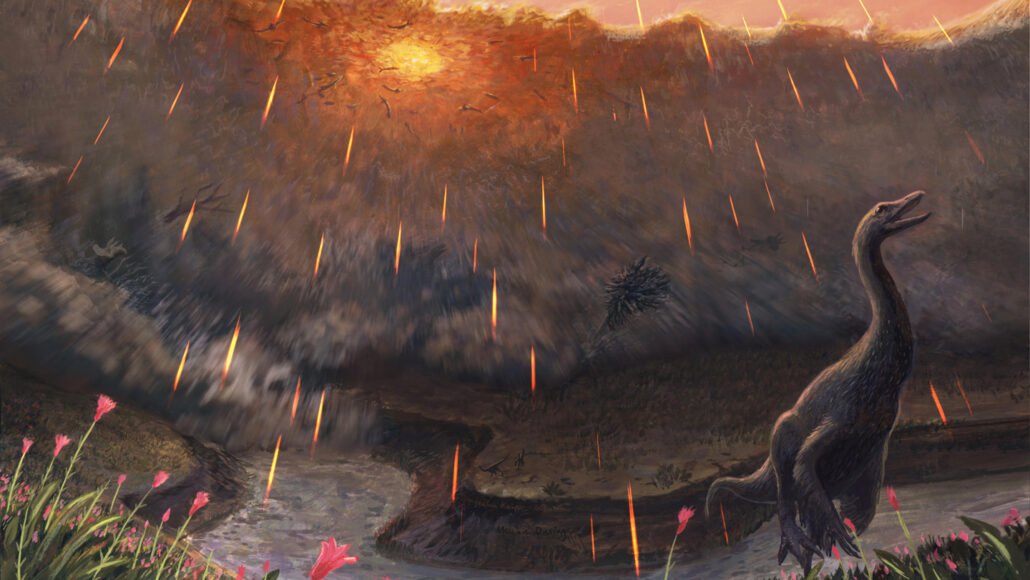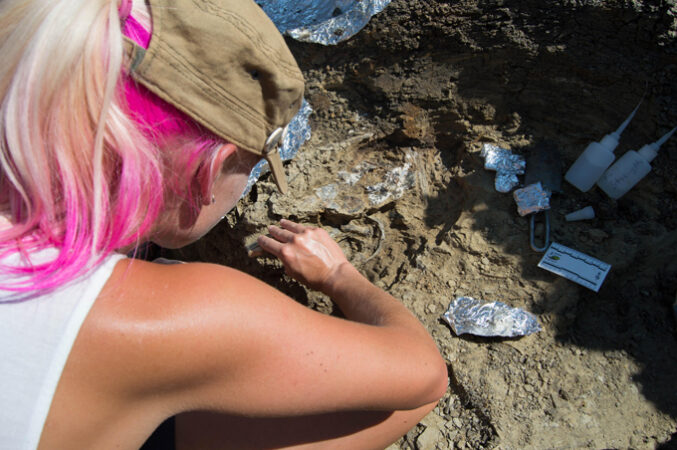The end of the dinosaurs appears to have come in springtime
Fish fossils from North Dakota suggest when an Earth-devastating asteroid hit off Mexico

The Chicxulub asteroid impact off the coast of Mexico occurred about 66 million years ago. It triggered devastating flooding at a site in North Dakota (illustrated). This dino-killing impact took place in spring, data now suggest.
Joschua Knüppe
By Sid Perkins
About 66 million years ago, a massive asteroid slammed into the Gulf of Mexico. Not long afterward, all nonbird dinosaurs died as did many other species on land and in the sea. Scientists don’t know the exact year this took place. But they now think they have figured out in what season it occurred: spring.
The finding comes from a new analysis of bones. These fossils of ancient fish had been entombed at a site in southwestern North Dakota. It’s known as Tanis.
Researchers shared their new discovery February 23 in Nature.
The asteroid was big — some 10 kilometers (more than 6 miles) across. It struck with a mighty force off the Mexican coast, close to the modern-day town of Chicxulub (CHEEK-shuh-loob). Many birds, small mammals and other creatures survived the global devastation this collision unleashed. Pinning down the season when it happened could help scientists better understand why these species were able to persist amidst a general global reign of death.
If the spring date proves correct, for instance, creatures that winter in underground burrows would have just been emerging and active in the Northern Hemisphere. This would have left them very vulnerable. In contrast, this same time would have been autumn in the Southern Hemisphere. Any hibernating creatures there should have been more protected, having just settled in for a season-long nap.

Educators and Parents, Sign Up for The Cheat Sheet
Weekly updates to help you use Science News Explores in the learning environment
Thank you for signing up!
There was a problem signing you up.
Telltale bands of growth
Scientists discovered the Tanis fossil site in 2008. Its sediments appear to capture the flooding of a riverbed and other destruction that happened immediately after the Chicxulub impact. Previous work also suggested that some fish fossils here had tiny round shapes on them. These appear to be solidified globs of molten and vaporized rock — material that had been flung skyward by the asteroid impact. And tiny globs were in the fishes’ gills. That’s a strong sign that the animals were alive and breathing as devastation rained down upon them.
“These creatures died incredibly close to the moment that debris was coming down,” says Thomas Holtz Jr. He’s a vertebrate paleontologist who did not take part in the new study. He works at the University of Maryland in College Park.
Some fish bones have features that can record seasonal and annual cycles of growth. These are similar to the growth rings in trees. Such patterns in bone typically appear as alternating thick and thin bands. The thick ones develop during a time of vigorous growth. The thinner bands mark times of slower bone growth. There’s also a third type of feature known as a “line of arrested growth.” It usually points to winter — or sometimes to periods of famine or drought.
Melanie During is a vertebrate paleontologist at Uppsala University in Sweden. To figure out in which season the asteroid struck, she and her colleagues examined the jawbones of three paddlefish. They also looked at bony spines in the pectoral fins of three sturgeons. The outermost layers of all six analyzed bones indicate rapid growth, During says. But that growth hadn’t yet reached the peak seen in previous years’ bands. Growth tends to peak in summer. So the last growth band in the Tanis fossils points to these fish having died before summer.

The regularity of the lines of arrested growth seen in the fish bones also suggests strongly that the fish weren’t suffering from drought or famine when they died. In fact, During says, “By all indications, these fish were doing fine.” Taken together, she says the fossils point to the Northern Hemisphere spring as when the dino-killing impact took place.
“I really do think this is a solid story backed by strong evidence,” says Stephen Brusatte. He’s a vertebrate paleontologist who works at the University of Edinburgh, in Scotland. The asteroid impact “would have turned a season that is normally about growth and flowering and rebirth into a time of unbelievable fire and fury,” he notes.
Despite the passage of more than 66 million years, Holtz says, “it’s pretty amazing that we can look at Earth’s worst day and figure out the time of year it was.”







